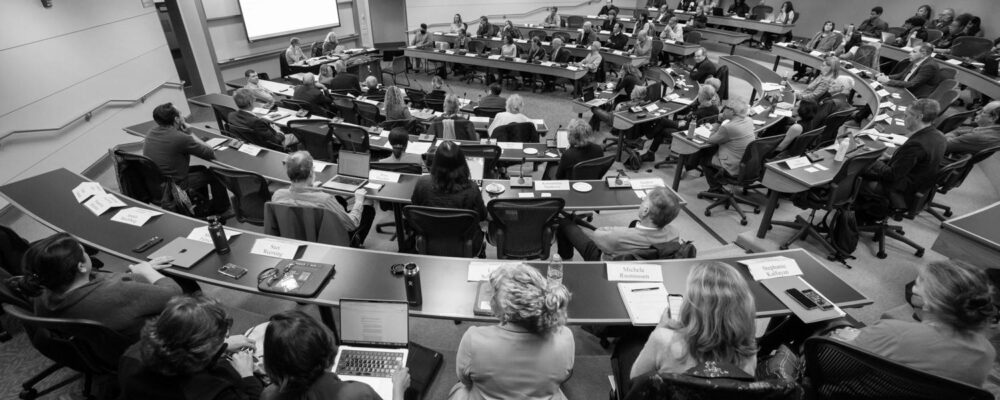Americans aren’t good at managing their money — and there are signs that the problem is getting worse.
Already saddled with record levels of student debt, young adults today, for example, are even more unlikely to monitor their credit card debt and bank balances. Some people trick themselves into thinking that store refunds or anything less than $5 amount to free money. And too many people pay for online subscriptions they don’t use.
Thanks to the pioneering work of Stanford economist Annamaria Lusardi, numerous studies show how little people know about money. For two decades, Lusardi has been tracking financial literacy rates using three basic questions that she helped design and are now used as a standard measure around the world.
Her latest analysis of how Americans responded to those three questions in 2021 underscores their lack of financial know-how.
Only 53.1 percent of respondents demonstrated an understanding of how inflation works as prices on everything from cereal and cars were spiking. About two-thirds (69.4 percent) knew how to do a simple interest-rate calculation, but only 41.5 percent understood how, when it comes to investment risks, mutual funds are generally safer investments than a single company’s stock.
In all, just 28.5 percent of survey participants answered all three questions correctly, while the rest either got them wrong, or indicated they didn’t know.
The results are especially troubling as methods of managing money have evolved, says Lusardi, a globally recognized expert on personal finance who joined Stanford in September as a senior fellow at the Stanford Institute for Economic Policy Research (SIEPR) and director of the new Financial Freedom Initiative. Workers now shoulder more of their retirement planning; consumers quickly and easily move money using their mobile phones; and investors make increasingly complex decisions.
“The world is changing really fast and we just expect people to have the skills to make financial decisions that have critical lifelong impacts,” says Lusardi, who is also a professor of finance (by courtesy) at the Graduate School of Business (GSB).
High rates of financial illiteracy are also problematic, she says, given today’s heightened economic uncertainty and growing wealth inequality. Respondents who were young, less educated, female, or not employed scored the lowest. Black Americans and Hispanics were also among the least financially literate.
A global pattern of illiteracy
Financial illiteracy, it turns out, is pervasive around the world, according to a newly published global analysis in the Journal of Financial Literacy and Wellbeing. Whether they are in a Nordic country with strong education systems, like Finland, or in a Latin American country, like Peru, which experienced inflation in 1990 upwards of 10,000 percent, most people don’t understand how money works, says Lusardi. And just like in the United States, the least knowledgeable tend to be women, racial minorities, the least-educated, and the unemployed.
Lusardi’s latest U.S. analysis — co-authored with Jialu Streeter, the executive director and a senior research scholar at SIEPR — is part of a special edition of the journal that includes analyses of 16 countries. Each study in the issue is based on the results of the “Big Three” questions that Lusardi and her longtime collaborator, economist Olivia Mitchell of The Wharton School at the University of Pennsylvania, crafted 20 years ago.
In 2011, Lusardi oversaw and contributed to a similar series of country comparisons — which yielded similar results and appeared in the Journal of Pension Economics & Finance.
“Financial illiteracy has been and continues to be a global phenomenon,” says Lusardi, who is one of the founders and inaugural editors of the Journal of Financial Literacy and Wellbeing, published by Cambridge University Press.
Why the ABCs of money matters
Beyond measuring and analyzing financial literacy rates, Lusardi’s extensive research has found how people who understand basic financial concepts are better at managing money. They save more for retirement, make smarter investment decisions, and manage their debts more effectively. Lusardi’s latest study shows that people who are financially literate are more likely to have money on hand to weather at least the early stages of an economic shock like a pandemic.
Lusardi has also shown that people think they know more about personal finance than they actually do, which she says makes them even more vulnerable to poor decision-making.
Stanford’s commitment to improving financial literacy is a key reason Lusardi says she joined The Farm. In addition to the Financial Freedom Initiative — a collaboration between SIEPR, the GSB, and the Department of Economics in the School of Humanities and Sciences — Lusardi continues to serve as academic director of the Global Financial Literacy Excellence Center, which she founded in 2011. Prior to Stanford, Lusardi was the University Professor of Economics and Accountancy at The George Washington University.
The Big Three as global standard
In Lusardi, Stanford gains a leader in establishing financial literacy as a specialty within the field of economics.
Lusardi’s contributions to the field began in 2004, when The University of Michigan’s closely watched Health and Retirement Study added the so-called Big Three to a module dedicated to financial literacy and retirement planning. Then, in 2009, the financial education arm of the Financial Industry Regulatory Authority, which helps provide oversight of registered securities brokers and brokerage firms, began incorporating the same measures in its triennial survey of roughly 25,000 Americans.
Since then, other organizations, including central banks around the world, have integrated the Big Three into their respective assessments of household finances.
The underlying datasets in these surveys differ, but the results have uniformly shown that most people don’t understand how money, or financial systems broadly, functions, Lusardi says. In the U.S., this remained the case even after the Great Recession of 2008 and 2009 — the most severe economic downturn since the Great Depression — buffeted household finances.
“The continuous surprise is just how low financial literacy is in the United States and around the world,” says Lusardi, whose policy work includes advising the U.S. Treasury, the Organisation for Economic Co-operation and Development, and chairing the Italian Financial Education Committee in charge of designing a national strategy for financial literacy.
Solutions in education
To Lusardi, the answer to financial illiteracy lies in providing people with a basic education on the ABCs of personal finance.
“Developing personal finance skills is as important as learning how to read and write,” says Lusardi, who has been teaching financial literacy to undergraduate and graduate students for more than a decade. In fact, her move to Stanford is rooted in her experience working with SIEPR’s Michael Boskin and John Shoven to organize the first annual Teaching Personal Finance Conference in 2022.
“I’m not talking about expecting people to become Warren Buffet,” she says. “I’m talking about teaching people, especially the young, how to make savvy financial decisions. For first-generation or low-income students, it often means talking about topics they seldom discuss with their parents.”
Even as personal finance education has become somewhat of a cottage industry, results are mixed at best. Instructors, Lusardi says, often lack training and students tend to forget what they learn. In a 2014 journal publication, Lusardi and Mitchell noted that lack of sufficient funding or teacher training in financial education are still an issue; in a follow-up paper published this past fall, however, they said there’s reason for optimism.
More than half of U.S. states, for example, have added personal finance instruction as a high school graduation requirement. Universities, including Stanford, are now offering personal finance courses. Employers, too, are recognizing that financial anxiety hurts employee productivity and are sponsoring personal finance lessons in the workplace.
“Financial literacy education is really accelerating,” Lusardi says. “We’re finally seeing things turn around and, to me, that’s a very positive result.”
“Stanford University, officially Leland Stanford Junior University, is a private research university in Stanford, California. The campus occupies 8,180 acres, among the largest in the United States, and enrols over 17,000 students.”
Please visit the firm link to site






